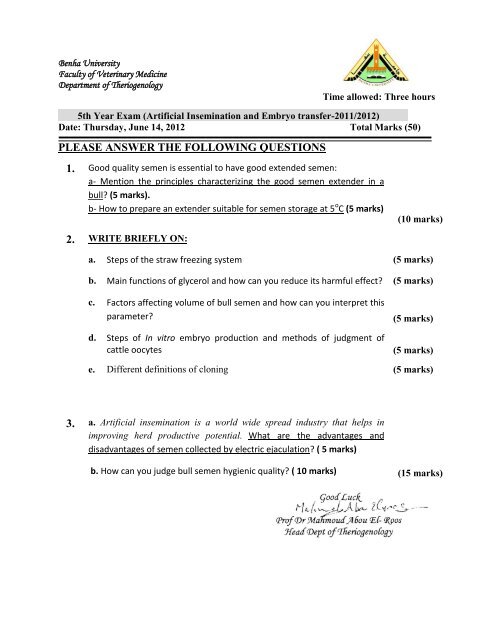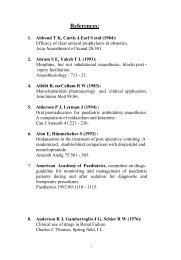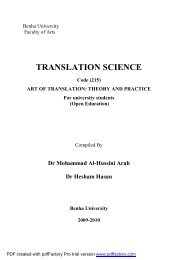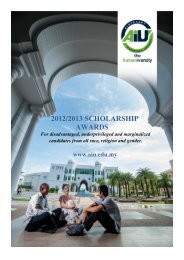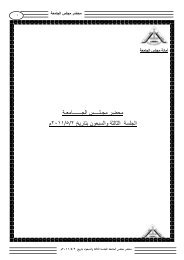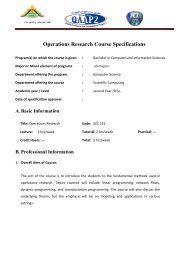PLEASE ANSWER THE FOLLOWING QUESTIONS
PLEASE ANSWER THE FOLLOWING QUESTIONS
PLEASE ANSWER THE FOLLOWING QUESTIONS
You also want an ePaper? Increase the reach of your titles
YUMPU automatically turns print PDFs into web optimized ePapers that Google loves.
Benha University<br />
Faculty of Veterinary Medicine<br />
Department of Theriogenology<br />
Time allowed: Three hours<br />
5th Year Exam (Artificial Insemination and Embryo transfer-2011/2012)<br />
Date: Thursday, June 14, 2012 Total Marks (50)<br />
<strong>PLEASE</strong> <strong>ANSWER</strong> <strong>THE</strong> <strong>FOLLOWING</strong> <strong>QUESTIONS</strong><br />
1. Good quality semen is essential to have good extended semen:<br />
a- Mention the principles characterizing the good semen extender in a<br />
bull? (5 marks).<br />
b- How to prepare an extender suitable for semen storage at 5 o C (5 marks)<br />
2. WRITE BRIEFLY ON:<br />
(10 marks)<br />
a. Steps of the straw freezing system (5 marks)<br />
b. Main functions of glycerol and how can you reduce its harmful effect? (5 marks)<br />
c. Factors affecting volume of bull semen and how can you interpret this<br />
parameter? (5 marks)<br />
d. Steps of In vitro embryo production and methods of judgment of<br />
cattle oocytes (5 marks)<br />
e. Different definitions of cloning (5 marks)<br />
3. a. Artificial insemination is a world wide spread industry that helps in<br />
improving herd productive potential. What are the advantages and<br />
disadvantages of semen collected by electric ejaculation? ( 5 marks)<br />
b. How can you judge bull semen hygienic quality? ( 10 marks) (15 marks)
Benha University<br />
Faculty of Veterinary Medicine<br />
Department of Theriogenology<br />
Model Answer<br />
Time allowed: Three hours<br />
5th Year Exam (Artificial Insemination and Embryo transfer-2011/2012)<br />
Date: Thursday, June 14, 2012 Total Marks (50)<br />
<strong>PLEASE</strong> <strong>ANSWER</strong> <strong>THE</strong> <strong>FOLLOWING</strong> <strong>QUESTIONS</strong><br />
1. Good quality semen is essential to have good extended semen:<br />
a- Mention the principles characterizing the good semen extender in a bull? (5 marks).<br />
Answer:<br />
Characters of good semen extender: The essential properties of a good diluter are:<br />
1- Osmotic pressure.<br />
- If the tonicity of the medium deviates considerably, spermatozoa may have bent tails,<br />
swim in circles, and die.<br />
- Extenders developed to preserve sperm should ideally be isotonic under the conditions<br />
used, and thus should not cause morphological or functional damage.<br />
- Solutions that are similar in composition to body fluids or are naturally produced liquids,<br />
such as egg yolk and milk; appear to be compatible with sperm.<br />
2- Buffering capacity:<br />
Spermatozoa require protection from metabolic by-products, primarily lactic acid,<br />
especially when they are stored without refrigeration. Buffering solutions protect sperm<br />
cells from even minute changes in pH due to lactic acid formation.<br />
3- Protect sperm cells against cold shock.<br />
- To protect spermatozoa against the effect of chilling, lecithin, proteins, lipoproteins and<br />
similar complexes found in Egg yolk or milk will be provided<br />
4- Protect sperm cells against freeze kill.<br />
It is necessary to added antifreeze kill e.g. glycerol to semen to protect it during<br />
freezing and thawing.<br />
Glycerol binds water decreases the freezing point of solution. Less ice is formed<br />
in its presence at any temperature.<br />
The level of glycerol varies somewhat with the extender ingredients.<br />
Yolk-citrate, whole milk, and Tris-buffered-yolk should contain 7%.<br />
Skim milk extender performs better with 10% glycerol.<br />
5- Control bacterial growth and/or contamination<br />
- Some organisms usually will be found in semen from healthy bulls even under aseptic<br />
semen collection and processing conditions. It is therefore standard practice to include<br />
antibiotics such as penicillin and streptomycin in all extenders used commercially.
- Penicillin (1,000 IU/ml) and streptomycin (1,000µg/ml) were used to control both<br />
pathogenic and non-pathogenic bacteria in semen and reduce sperm metabolism as well.<br />
- The antibiotic polymyxin B was reported to increase fertility of frozen semen but failed<br />
to demonstrate an improvement when added to extenders containing both penicillin and<br />
streptomycin.<br />
- Clindamycin and tylosin were effective against several mycoplasma and ureaplasma<br />
isolates of bovine origin<br />
6-Provide nutrients.<br />
Spermatozoa, requiring energy for motility, are capable of both aerobic and anaerobic<br />
metabolism. Semen extenders should supply a simple energy source such as glucose or<br />
fructose in order to protect the intracellular reserves of spermatozoa as well as cell<br />
components. Fructose is available in seminal plasma, while egg yolk contains some<br />
glucose and other compounds utilizable by bull spermatozoa<br />
Some examples of nutrients used in semen extenders:<br />
1. Egg yolk (most common)<br />
2. Milk<br />
3. Coconut milk<br />
4. Reconstituted dried buttermilk<br />
7- Protect cellular enzymes.<br />
Extenders should contain substances that protect against the increase in the metabolic<br />
activity e.g. CO2 and organic acids (Caproic acid) and consequently maintain sperm<br />
viability, livability and metabolic activity.<br />
8- Free from toxic substances and/or bacterial products.<br />
- Not only should extenders be formulated to prevent the formation of toxic products<br />
during storage, but should be free of substances that are harmful to spermatozoa.<br />
- Heavy metals are harmful to spermatozoa, proper distillation of water insures that only<br />
nontoxic trace amounts remains.<br />
- Only pure reagents shouod be used in formulating buffer.<br />
- Dead spermatozoa are a source of amino acid oxidase which is harmful to surviving<br />
cells through the production of H2O2.<br />
9- Cheap and easy to be prepared.<br />
10- Maintain the life span of sperm with minimal drop of fertility.<br />
******************************************************************************<br />
b- How to prepare an extender suitable for semen storage at 5 o C (5 marks)<br />
Answer:<br />
a) Egg yolk based extenders:<br />
Egg yolk phosphate extender<br />
◦ Phosphate buffer-----------80ml<br />
Sod. Dibasic phosphate 2.0g<br />
Pot. Dihydrogen phosphate 0.2g
◦ Fresh egg yolk--------------20m<br />
Egg yolk citrate extender<br />
◦ Citrate buffer-----------80ml<br />
Sod. Citrate monohydrate 2.9g<br />
◦ Fresh egg yolk--------------20m<br />
Egg yolk tris extender<br />
◦ Tris buffer-----------80ml<br />
Tris 3.02g<br />
Citric acid 1.678g<br />
Fructose 1.0g<br />
◦ Fresh egg yolk--------------20ml<br />
Egg yolk lactose extender<br />
◦ Lactose 11.5%---------------80ml<br />
◦ Fresh egg yolk---------------20m<br />
Milk based extenders:<br />
Whole homogenized milk heating milk to 92-95°c in water bath for 10min. Cool to room<br />
temp. remove surface scum. Add antibiotics<br />
Skim milk extender<br />
Protocol of preparation of the extender:<br />
- Egg yolk preparation:<br />
1. Selection of the egg: the egg must be fresh and from healthy flock.<br />
2. Wash the egg with detergent.<br />
3. Cleaning of the egg shell with alcohol and dried in air and held near a benzene burner<br />
flame.<br />
4. Make a crack in the egg shell at the middle of its length.<br />
5. Allow the egg white to get out.<br />
6. Place the egg yolk on a dried clean filter paper, puncture with sterile glass rod and<br />
pour the yolk in a graduated glass cylinder.<br />
7. Filtrate the yolk to get rid of the yolk membrane.<br />
- Citrate buffer preparation:<br />
Weigh out the specified amount of citrate (29 gm) buffer to make 1 liter.<br />
- Extender preparation:<br />
1. Bring both the yolk and buffer to the same temperature (37°C) before mixing to<br />
avoid salt precipitation.<br />
2. Mix the egg yolk together with buffer in a graduated cylinder at ratio 20-40% of<br />
the extender volume.<br />
3. Add the antibiotic cocktail e.g. penicillin (1000IU/ml) and streptomycin (1000<br />
µg/ml). at the appropriate concentration to the extender.
4. Keep the prepared extender in water bath at 37°C until dilution of extension of<br />
semen.<br />
******************************************************************************<br />
2. WRITE BRIEFLY ON:<br />
a. Steps of the straw freezing system (5 marks)<br />
Answer:<br />
- The semen is cooled in straw made from polyvinyl chloride and sealed with polyvinyl<br />
alcohol powder (some machine sealed them electrically)<br />
- Semen straws are placed in water whereby the polyvinyl alcohol polymerizes so that a<br />
firm solid seal is formed.<br />
- Freezing of the straws takes place by placing them horizontally on a rake 4-7 cm above<br />
the surface of liquid nitrogen.<br />
- After freezing for 10 minutes, straws are transferred to the liquid nitrogen.<br />
******************************************************************************<br />
b. Main functions of glycerol and how can you reduce its harmful effect? (5 marks)<br />
Answer:<br />
Function of glycerol:<br />
To reduce the harmful effect caused both by the formation of crystals and by the changes in the<br />
concentration of electrolytes.<br />
How glycerol do his role:<br />
glycerol is added to the medium. Its addition modifies, however, the crystal formation in the<br />
medium, so that the mechanical damage to the sperm during the crystallization process is<br />
reduced partly because the crystals become the crystals mass more homogenous. Glycerol also<br />
enters and partly replaces free water, resulting in a sort of osmotic buffering action.<br />
- The freezing point of bull semen is –0.55C but the formation of crystals does not occur until –<br />
1.7C has been reached. Adding of glycerol (7%v/v) to semen which has been diluted with the<br />
conventional diluents, lower the freezing point to -3ºC, but super cooling to approximately -<br />
10C.<br />
To reduce harmful effect of glycerol:<br />
Early reports suggested addition of cryoprotectant in steps gradually increasing concentration. `<br />
******************************************************************************<br />
c. Factors affecting volume of bull semen and how can you interpret this parameter?<br />
(5 marks)<br />
Answer:<br />
1- The semen volume is influenced by<br />
a- Species: Larger in cattle than buffaloes.<br />
b- Breed: Larger in dairy than beef.
c- Season: Larger in green than dry seasons<br />
d- Sequence: Larger in second than first ejaculate<br />
e- Age: Larger in mature than younger bulls.<br />
f- It differs from species to another.<br />
Bull: 0.5 – 8ml Ram, Buck: 0.3 – 2 ml Stallion: 30 – 105 ml<br />
Boar: 250 – 350 ml Camel: 10 – 15 ml Dog: 0.5-40 ml<br />
******************************************************************************<br />
d. Steps of In vitro embryo production and methods of judgment of cattle oocytes<br />
(5 marks)<br />
Answer:<br />
Steps of in vitro embryo production are<br />
In vitro oocyte maturation (IVM)<br />
Oocyte in vitro fertilization (IVF)<br />
Invitro sperm preparation and capacitation.<br />
Invitro oocyte fertilization and sperm-oocyte interaction.<br />
In vitro culturing (IVC)<br />
1- Oocyte collection, classification and selection:<br />
The vast number of oocytes normally wasted in the abattoir can be tapped by recovering the<br />
ovaries and releasing the oocytes from dissected 2-5 mm follicles .<br />
Methods of oocytes collection:<br />
1) Dissecting the intact follicle<br />
2) Aspiration techniques:<br />
3) Slicing methods<br />
4) Puncture method:<br />
5) Oocyte Recovery: Laparoscopic ovum pick-up (LOPU)<br />
6) Oocyte Recovery: ultrasound-guided trans-vaginal oocyte retrieval<br />
Methods of oocyte classification<br />
1) On the basis of cumulus cells<br />
a) Cumulus cells should establish intimate contacts together as well as with the oocyte to<br />
allow cell communication through gap junctions, which were necessary for efficient<br />
maturation of the oocyte. The surrounding cumulus cells had an essential role not only in<br />
nuclear maturation but also in cytoplasmic maturation which was needed for male<br />
pronuclear formation.<br />
b) So the presence of an intact complete and compact cumulus cells investment with a<br />
homogenous appearance of the ooplasm surrounding the oocyte were the best predictive<br />
morphological criteria of immature oocyte ability to undergo maturation and high<br />
embryonic development.
c) Cumulus cell expansion observed at the time of oocyte collection might reflect follicular<br />
atresia or premature meiotic resumption in the oocyte.<br />
1) On the COCs basis the oocyte classified into:<br />
a) Those in which a dark rim of corona cells was visible around the zona pellucida (ZP)<br />
b) Those in which the corona displayed the same density as the cumulus cell mass; where,<br />
the COCs with a dark rim of corona cells matured at a higher rate<br />
2) Follicular size<br />
Follicular size affecting the developmental capacity of bovine oocyte; Upon size basis ,<br />
follicles can be categorized into three groups:<br />
a) > 4 to 8 mm (large)<br />
b) 2 to 4 mm (medium)<br />
c) ˂ 2 to 1mm in diameter (small)<br />
Where, high percentages of embryonic development and blastocyst rate recovered from the<br />
large follicles, as they have many layers of cumulus cells.<br />
Oocyte selection:<br />
On the basis of visual assessment of morphological features by the presence of:<br />
An intact complement of cumulus oophorus cells (COCs) surrounding the oocyte.<br />
A homogenous appearing ooplasm.<br />
Oocytes obtained from 6-7 mm follicles, having many layers of cumulus cells produced<br />
significantly higher proportion of morula / blastocyte stage embryos (65.9%) compared<br />
to those obtained from 2-6 mm follicles (34.3%).<br />
2- Oocyte maturation:<br />
- Maturation is achieved by cultivating the oocytes for 24-26 hrs in medium containing<br />
estrous cow serum.<br />
- Most oocytes will reach the second metaphase stage of meiosis during culture but not all<br />
have the full potential for development .<br />
- Matured oocytes are then cultured with sperm capacitated in vitro and up to 90%<br />
fertilization can be achieved with some bulls .<br />
- During maturation, there is a germ vesicle break down (GVBD) expressed by extrusion<br />
of the polar body (in 80% of oocytes between 12 and 18h of culturing) Such oocytes<br />
showed significant higher rates of cleavage and development.<br />
- The thickness and compactness of COCs affects IVM culture period (with an apparently<br />
6 h delay in heavily compacted COCs).<br />
- 24 h maturation period is superior for cattle and buffalo oocytes' maturation in-vitro.<br />
3- Preparation of sperm for IVF:<br />
a- Evaluation of frozen semen:
The use of computer – assisted motility analysis (CASMA) OR Computerized semen<br />
analyzer (CSA).<br />
Swim up technique.<br />
Gloss wool filtration technique.<br />
Use of hyaluronic acid.<br />
Semen sexing.<br />
Washing of semen.<br />
b- Sperm capacitation for IVF<br />
Sperm capacitation is a sequence of biochemical and physiological changes in the outer<br />
sperm membrane that enable the sperm to undergoes the acrosomal reaction in response<br />
to the zona pellucida.<br />
Acrosomal reaction involves:<br />
Fusion and breakdown of the sperm plasma and outer acrosome releasing the<br />
acrosomal enzymes.<br />
Hyper activation of sperm motility that normally occurs near and/or on the zona<br />
pellucida.<br />
A change in the sperm membrane permeability to calcium appears to be the<br />
primary signal for acrosomal reaction.<br />
In-vitro capacitation of bull spermatozoa has been achieved by incubation of fresh semen<br />
in:<br />
Heparin (10 – 20 ug/ml).<br />
Bovine follicular fluid<br />
Calcium ionophore A-23187<br />
Caffeine-benzoate (5 – 10 mM).<br />
Fresh semen requires a longer in-vitro capacitation period than frozen-thawed semen.<br />
Fresh semen gives better penetration rate than frozen–thawed semen.<br />
Frozen-thawed semen is likely to deteriorate more rapidly than fresh semen.<br />
4- Invitro oocytes fertilization:<br />
o Activation of the oocyte by the presence of spermatozoa.<br />
o The vitellus shrinks in volume, expelling fluid into the perivetilline space.<br />
o The sperm head in the vitellus swells and acquires the consistency of gel forming a male<br />
pronucleus.<br />
o The sperm head decondensation occurs within 1 – 24 h of oocyte penetration and the<br />
pronucleus develops after a further 3 – 5 h.<br />
o There was a significant increase in rates of penetration and fertilization from 66% to 93%<br />
after 8 – 24 h sperm – oocyte incubation.<br />
o Oocytes and associated cells produce and secrete substances promoting fertilization<br />
The evidences of successful in-vitro fertilization are:
Penetration of the sperm into the ooplasm.<br />
Swelling of the sperm head.<br />
Pronucleus formation.<br />
Morphologically normal cleavage.<br />
Blastocyst formation.<br />
Breakdown of cortical granules.<br />
Evidence of a sperm tail in the ooplasm<br />
******************************************************************************<br />
e. Different definitions of cloning (5 marks)<br />
Answer:<br />
Cloning is to make multiple identical copies of (a DNA sequence). To create or propagate<br />
(an organism) from a clone cell: clone a sheep. To reproduce or propagate asexually: clone<br />
a plant variety. To produce a copy of; imitate closely<br />
Reproductive cloning is defined as the deliberate production of genetically identical<br />
individuals<br />
******************************************************************************<br />
3. a. Artificial insemination is a world wide spread industry that helps in improving herd<br />
productive potential. What are the advantages and disadvantages of semen collected by electric<br />
ejaculation? ( 5 marks)<br />
Answer:<br />
Advatages:<br />
1- This method is used only when there is failure in the natural service due to crippled<br />
condition e.g. diseases of legs and loin, bad temper, etc.<br />
2- it is used in some bulls refuse to serve in the artificial vagina or suffer from lack of libido<br />
or unaccustomed to chutes, restraints, and people.<br />
3- Can be useful for collecting semen from anesthetized wild animals.<br />
4- It does not require a mount animal.<br />
Disadvantages:<br />
1- Need a special apparatus which is quite expensive.<br />
2- It depends on electric ejaculation which looks bad for the bull is anxious and tries to lay<br />
down and kicks.<br />
3- Accidental laying down of bull in response to overuse of electrical stimulation lead to<br />
fracture.<br />
4- Not used for all animals.<br />
******************************************************************************<br />
b. How can you judge bull semen hygienic quality? ( 10 marks)<br />
Answer:<br />
1) Bromo-thymol blue-catalse test (BTBCT):
- It is necessary for assessing the hygienic quality of semen. Such test depends<br />
mainly on the fact that semen contains a very small amount of the hydrogen<br />
peroxide splitting enzyme “Catalase”, and its presence in excess is an indication<br />
to the presence of abnormal admixtures e.g., pus, blood, bacteria, etc.<br />
- A special tube “the bromo-thymol-blue catalase tube” closed by a rubber plug<br />
provided with a capillary tube.<br />
- To 1 ml semen add 8 drops bromo-thymol blue 2% in 96% alcohol. The color<br />
change is an indication to pH of semen where it is yellow at pH 6 and dark blue at<br />
7.6.<br />
- To the contents of the tube add hydrogen peroxide 3% to a special mark on the<br />
wall. Put the plug and invert the tube. Examine after 5, 10, 15 and read after 20<br />
minutes.<br />
- If the amount of oxygen released above the column is more than 50 – 1000 µl,<br />
semen sample will be considered of bad hygienic quality and in such case it will<br />
be discarded.<br />
2) Methylene-blue reduction test (MBRT):<br />
- This test depends on the presence of dehydrogenase enzyme in the mitochondrial<br />
sheath of the spermatozoa, centers of the metabolic activity, which is localized in<br />
the middle piece. However, the rate of bacterial contamination influences the<br />
reduction time as the enzyme is also present in bacteria.<br />
- To nine parts of diluted semen with egg yolk-citrate add one part of MB 0.05%<br />
(in citrate or phosphate buffered solution). Mix and suck into a glass capillary<br />
tube, kept warm at 37C. Time of reduction of the methylene blue to<br />
leucomethylene blue is estimated. Reduction within 5-8 minutes is an indication<br />
to good quality semen.<br />
*************************************************************<br />
End of Model Answer<br />
Best wishes<br />
2012


